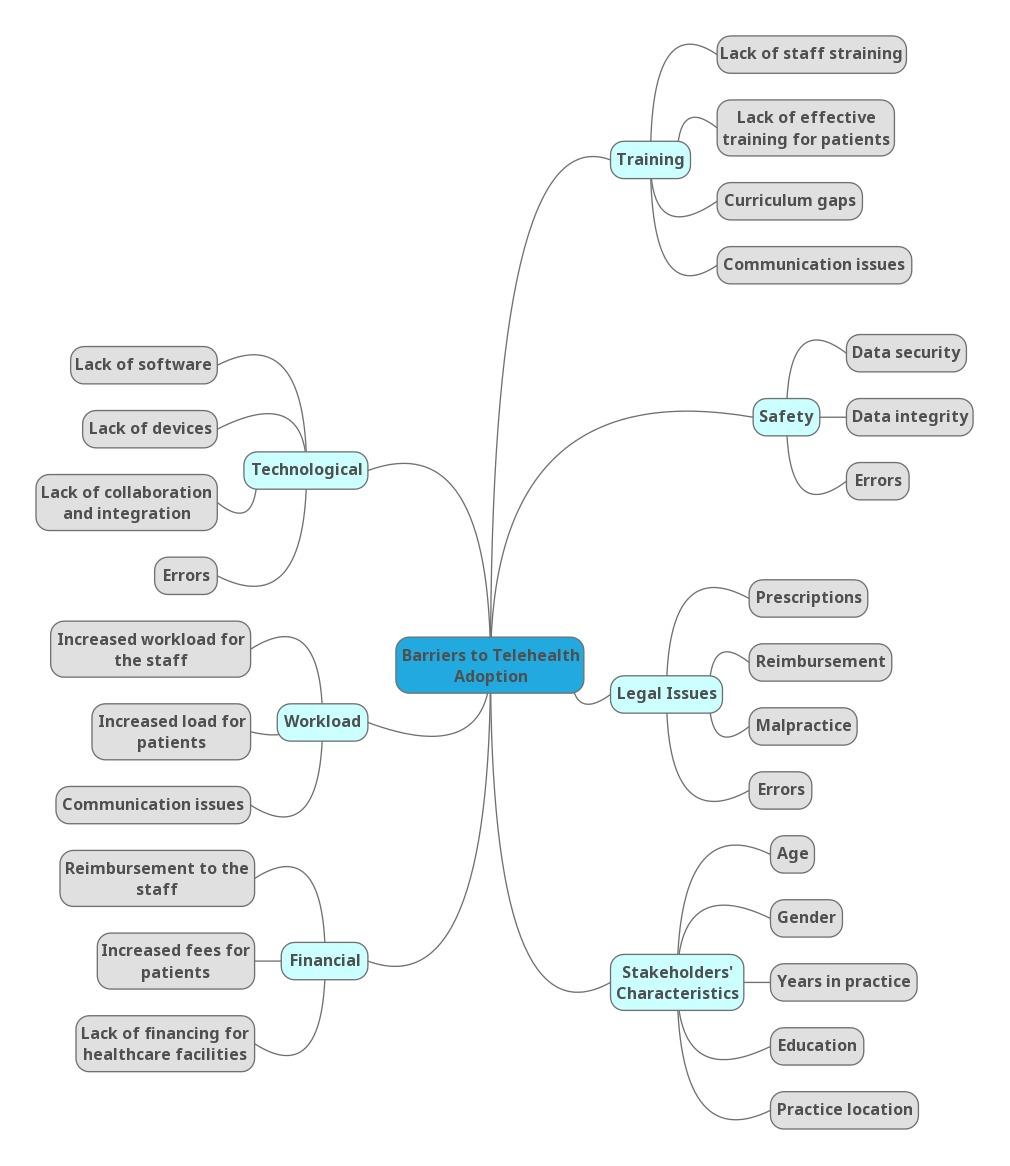Introduction
Telehealth technologies are often referred to as the future of family practice and the overall healthcare system as it increases Americans’ access to quality health care. The use of technology has proved to be beneficial in many cases especially when it comes to rural areas (Moore et al., 2017). The increasing use of telehealth is still seen differently by different stakeholders who have hopes, fears, success stories, and concerns. These diverse views, as well as some financial, technological, legal, and other limitations, have been associated with various barriers to the successful implementation of these advanced technologies. This paper reveals some of the most urgent and persistent barriers to the successful use of telehealth in family practice. The paper includes a precis where the central barriers are highlighted and a mind map revealing the major areas to consider when addressing the issue. The discussion section includes a detailed analysis of the concepts included in the mind map. The conclusion section provides a brief summary of the key points.
Précis
Moore, M., Coffman, M., Jetty, A., Klink, K., Petterson, S., & Bazemore, A. (2017). Family physicians report considerable interest in, but limited use of, telehealth services. The Journal of the American Board of Family Medicine, 30(3), 320-330. Web.
This article deals with the use of telehealth among family physicians and major barriers to the adoption of this technology. Moore et al. (2017) analyzed 1557 surveys that included such data as family physicians’ age, gender, years of work, practice ownership, services provided, practice location, and the use of telehealth. The researchers note that family physicians working in rural settings and in practices that are not privately owned were three times more likely to use telehealth while the participants mentioned such barriers as training, reimbursement, and costs. This article is a valuable source that expands the knowledge base on the use of telehealth services and associated barriers as seen by one of the largest groups of stakeholders.
Mind Map Discussion
In order to identify the major barriers to the adoption of telehealth in family practice, it is important to consider certain characteristic features of people using this technology. It has been found that healthcare professionals working with patients in rural settings are more likely top integrate telehealth technologies in their practice (Moore et al., 2017; Brown, Schmitz, Scott, & Friesner, 2017). Moore et al. (2017) also note that age, gender, education, years in practice, and distance are associated with different views on barriers to this technology adoption.

Some of the major areas of concern mentioned by healthcare professionals include financial, legal, safety, workload, technological, and training issues. Family practitioners stress that the provision of telehealth services is associated with some uncertainty in the area of reimbursement, which makes family physicians less eager to adopt new technologies (Moore et al., 2017). Patients are also reluctant to use telehealth services due to additional fees while hospitals often have inadequate resources to adopt the technology as their financing is quite limited (Davidson, Simpson, Demiris, Sheikh, & McKinstry, 2013). Financial barriers are closely connected with legal issues.
Unsolved prescription matters and malpractice problems are regarded as considerable obstacles to using telehealth. Safety concerns are also significant barriers as data confidentiality can be violated since more stakeholders and channels appear. Healthcare professionals note that the gaps in the legal status of telehealth technologies, as well as uncertainty in the way these services are reimbursed, contribute to this technology’s slow adoption (Davidson et al., 2013). People choose to use old ways that are associated with clarity, safety, and transparency.
Telehealth requires certain innovations and the development of some technologies. For instance, Davidson et al. (2013) note that the lack of proper software as well as limited integration of telehealth into information systems utilized in the healthcare facilities can potentially lead to various errors or loss of data. Family physicians also note that the integration of telehealth into the existing electronic record system will result in an increased workload for healthcare professionals (Moore et al., 2017). Furthermore, hospitals do not have enough resources to update their technologies.
Importantly, family physicians and nurses claim that insufficient training is one of the central obstacles to the adoption of telehealth. Brown et al. (2017) evaluated an intervention aimed at training the staff. The intervention was regarded positively by healthcare professionals who expressed their willingness to use telehealth technologies more actively. Females were more likely to mention the benefits of training as compared to male healthcare practitioners. Healthcare practitioners also add that curricula in medical schools are characterized by certain gaps that have to be addressed. However, the major focus is on on-job training.
Conclusion
In conclusion, the use of telehealth technologies in family practice often depends on such factors as healthcare professionals’ age, gender, education, years in practice, and the location of the practice. The primary barriers to effective adoption of telehealth include financial, legal, technological, workload, safety, and training issues. Importantly, the existing uncertainty associated with financial and legal aspects of the use of telehealth is contributing to the slow adoption of these technologies. Training is another influential factor affecting healthcare professionals’ views on the matter.
References
Brown, W., Schmitz, T., Scott, D., & Friesner, D. (2017). Is telehealth right for your practice and your patients with asthma? Journal of Patient Experience, 4(1), 46-49.
Davidson, E., Simpson, C., Demiris, G., Sheikh, A., & McKinstry, B. (2013). Integrating telehealth care-generated data with the family practice electronic medical record: Qualitative exploration of the views of primary care staff. Interactive Journal of Medical Research, 2(2), e29.